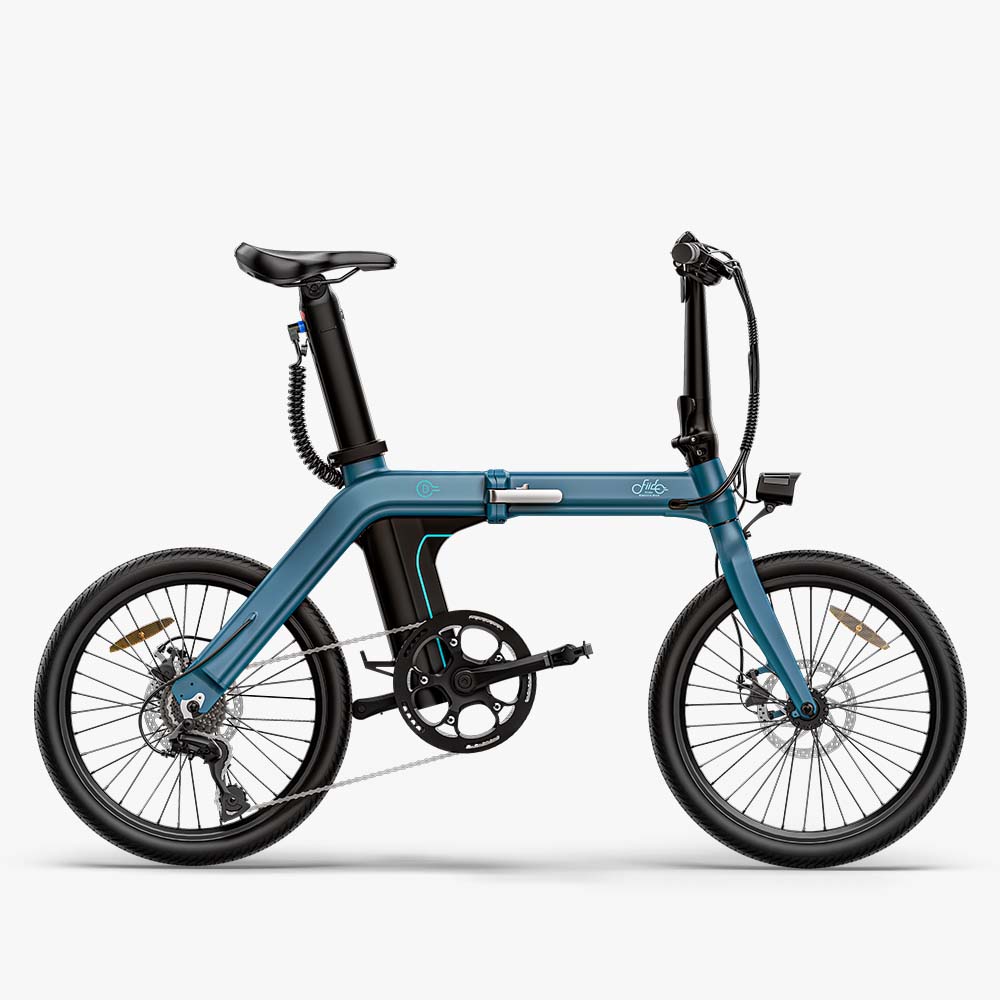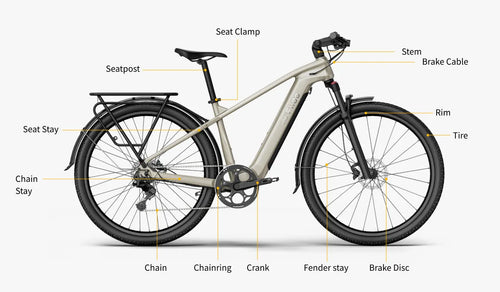The idea of traveling with an e-bike is becoming increasingly attractive, but many cyclists ask themselves the question: “Can I take my e-bike on a plane?”
In this article, we take a detailed look at airline regulations for transporting e-bikes, highlight precautions for a safe journey, and introduce suitable Fiido e-bike models.

Airline Regulations for E-Bikes
Battery Type and Transport Restrictions:
One of the most important aspects of transporting an e-bike by plane is the battery. E-bikes generally use lithium-ion batteries, which are particularly powerful but can also be dangerous, as they can overheat and catch fire under certain conditions. For this reason, most airlines have strict regulations regarding the carriage of lithium batteries. The International Civil Aviation Organization (ICAO) sets a maximum capacity limit of 100 watt-hours (Wh) for batteries in carry-on luggage. Batteries with a capacity between 100 Wh and 160 Wh are generally only allowed with the airline's approval, while batteries exceeding 160 Wh are generally prohibited on passenger aircraft.
Differences in Airline Policies:
The rules for transporting electric bike vary significantly between airlines, mainly due to lithium-ion battery restrictions. Some airlines only allow transport if the battery is removed and packed separately to minimize safety risks. For others, especially with larger batteries, transport is completely prohibited. Additionally, some airlines offer special services for transporting sports equipment. Under certain conditions—such as size and weight—e-bikes can be accepted as special baggage. Therefore, it is advisable to inquire early with the airline to avoid unexpected issues.
Advantages of Folding E-Bikes
Folding e-bikes are an ideal solution for travelers because they are more compact and easier to transport. Due to their smaller format, they more easily comply with airline size and weight restrictions. Folding models, such as the Fiido D11, can be quickly folded and stored in special bags, significantly simplifying transport by air. In many cases, folding e-bikes can also be declared as regular luggage, avoiding extra charges for oversized baggage.
Another advantage of foldable e-bikes is that they can be made road-ready again at the destination without much effort. Since they take up less space, they are also easier to carry on public transport or to store safely in a hotel room. This makes folding e-bikes an ideal choice for those who want to stay mobile while on vacation or on business trips without having to give up the benefits of an e-bike.

Preparation and Precautions
Battery Removal and Protection:
If transporting an e-bike by plane is allowed, it is crucial to remove the battery before the flight and pack it separately. This not only reduces the weight of the e-bike but also complies with the safety requirements of most airlines. The battery should be stored in a protective, fireproof bag to prevent damage during transport. Some airports offer special services to safely transport e-bike batteries.
Proper packaging of the battery is equally important. Ideally, it should be transported in a protective, fireproof bag that minimizes the risk of damage. These special bags are designed to prevent potential hazards from the battery, such as short circuits or overheating. Some airports also offer special services for the safe transport of e-bike batteries, providing travelers with additional safety.
Inquire in Advance at the Airport:
It is advisable to inquire in advance with the airline or the airport about the exact transport conditions. Each airline has its own regulations, and it may happen that additional fees are charged or certain requirements must be met. You should also find out whether the airline allows the transport of e-bikes at all, especially if you are flying with a low-cost carrier or a smaller provider.
Packaging the E-Bike
Proper packaging is crucial to protect the e-bike from damage during transport. Use a sturdy transport bag or a bike case to secure the frame and sensitive parts of the e-bike. Foam padding and protective film, as well as strong cardboard boxes and zip ties, are useful for the frame to prevent scratches and other damage. Make sure that all loose parts such as pedals and handlebars are well secured to avoid movement during the flight.

Alternatives to Air Transport of E-Bikes
Ground Transport:
If transporting an e-bike by plane seems too complicated or expensive, there is also the option of transporting the e-bike by ground service. This offers more flexibility and reduces concerns about battery and size restrictions.
Logistics companies or specialized bicycle courier services offer safe transport solutions for e-bikes, which are often more cost-effective than air transport. In this case, you should compare providers in terms of delivery time, insurance options, and price. Ground transport can also be less stressful, as the e-bike can be shipped as a whole and without major preparation.
Another advantage is that there are no restrictions on battery size, and the e-bike can often be transported without disassembly. Popular courier services such as DHL, UPS, or DB Schenker offer special rates for bicycle shipping.
Rental at the Destination
Another practical alternative is to rent an e-bike at the destination. In many cities and holiday resorts, there are now providers who rent out e-bikes on a daily or weekly basis. Platforms such as Lime or BikeMi offer e-bikes for short-term rental, while specialized providers such as RentABike or Bike Hire in larger cities provide high-quality e-bikes for longer periods. This can be especially beneficial if you only need an e-bike for a short stay or a specific event.
Recommended Fiido E-Bikes
Fiido D11 E-Bike:
The Fiido D11 is a lightweight, foldable e-bike that is particularly suitable for urban use. Weighing only 17.5 kg and with compact folded dimensions of 840 x 400 x 740 mm, it is extremely transport-friendly. The sturdy aluminum frame and minimalist design make it the ideal choice for air travel, as it can easily be stored in a bike transport bag or travel case. Moreover, the dimensions of the Fiido D11 have been recognized by ICAO (International Civil Aviation Organization), which facilitates air transport.
Transport Friendliness:
Thanks to its compact foldable design, the Fiido D11 Folding E-bike meets the standard size and weight limits of most airlines. It can be checked in as regular luggage, especially if the battery is removed and packed separately.
Battery and Range:
With a removable 417.6 Wh battery and a range of up to 100 km, the D11 is suitable for both long rides and daily commuting. The battery is easy to remove to comply with flight regulations.
Important:
Lithium batteries over 160 Wh may not be carried in checked luggage and are subject to strict carry-on restrictions, usually requiring special airline approval. It is recommended to contact the airline before departure to confirm the specific policies and avoid delays.
Fiido D11 Folding E-bike
Fiido D11, the best folding electric bike.
Fiido M1 Pro E-Bike:
The Fiido M1 Pro is a robust, foldable e-bike that is suitable for both city rides and off-road adventures. With its wide fat tires and full suspension, it easily handles rough terrain and offers maximum riding comfort.
Folding and Transport:
Like the D11, the Fiido M1 Pro is foldable, making air transport easier. With folded dimensions of 960*700*910 mm, which are recognized by ICAO, it offers significant advantages when traveling. However, at 26.8 kg, the M1 Pro is heavier than the D11, which may result in it being classified as oversized baggage. Despite the heavier weight, the powerful motor with 50 N·m torque provides enough energy to remain efficient both during travel and in everyday use.
Like the Fiido D11, the Fiido M1 Pro Fat Tire Electric Bike comes with a removable 614.4 Wh battery, which exceeds 160 Wh in capacity. Therefore, you must check with your airline in advance regarding a suitable shipping option.
User Feedback:
Many users report positive experiences when transporting the M1 Pro, especially regarding its ease of handling and the ability to take it on off-road excursions at the destination. Thanks to its high range and sturdy design, it is a reliable companion for travel.
Fiido M1 Pro Fat Tire Electric Bike
The most cost-effective fat tire ebike for off-road adventures.
Conclusion
It can be concluded that transporting e-bikes by plane is definitely feasible if the airline’s specific regulations are understood and followed in advance. The battery plays a central role, as it is subject to strict regulations and often needs to be packed separately. Careful preparation is essential to avoid unpleasant surprises. For travelers who find the effort too great, there are alternatives such as ground transport or renting e-bikes at the destination.
Models like the Fiido D11 and Fiido M1 Pro make transport easier thanks to their practical features and help ensure that the e-bike experience doesn’t have to be left behind when traveling. This way, the joy of riding continues—far from home.















